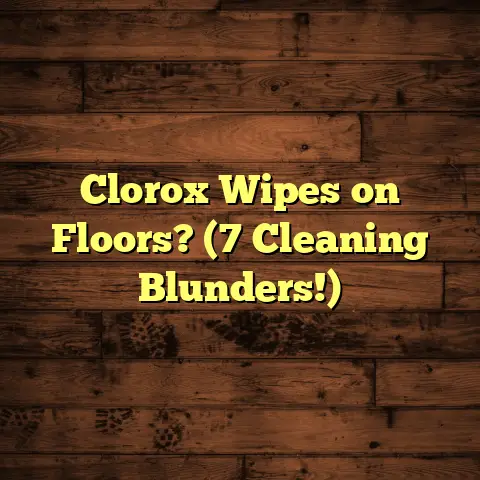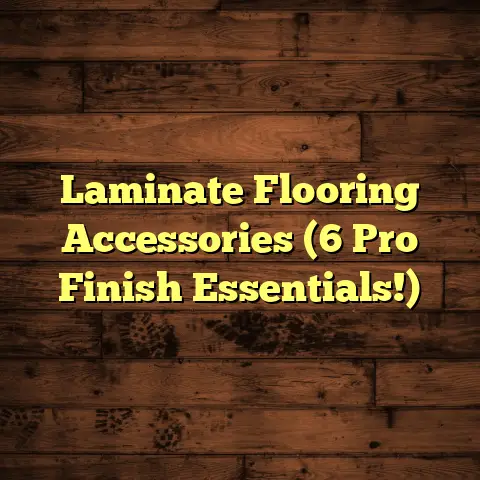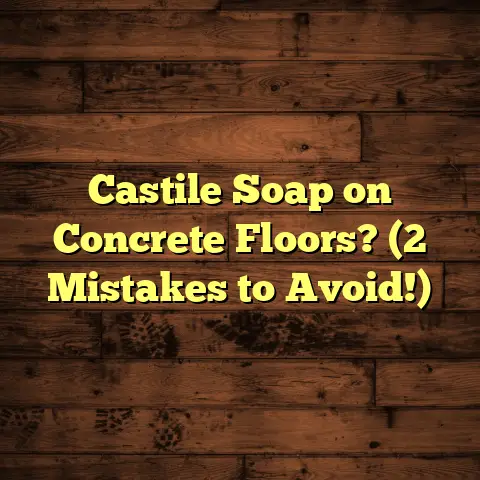Types of Interlocking Flooring? (6 Top Options!)
I’m here to chat about something that’s been revolutionizing the flooring world: interlocking flooring.
As a flooring contractor with years
under my belt, I’ve seen trends
come and go, but interlocking
systems?
They’re here to stay.
One of the biggest reasons? The ease of cleaning.
Seriously, who wants to spend hours
scrubbing floors?
With interlocking
flooring, maintenance becomes a
breeze.
Let’s dive in!
Overview of Interlocking Flooring
So, what exactly is interlocking
flooring?
Simply put, it’s a flooring
system where individual pieces –
whether they’re tiles, planks, or mats
– connect to each other through
a special edge design.
Think of it like a jigsaw puzzle,
but for your floor.
These edges
“click” or “snap” together, creating
a seamless and often floating floor.
Why the Buzz?
Interlocking flooring has exploded in
popularity, and for good reason.
It’s incredibly versatile, working
well in residential and commercial
settings.
From basements to boutiques, people are loving the ease of installation and the stylish looks you can achieve.
A Quick History
Believe it or not, interlocking
flooring isn’t a brand-new invention.
While the modern versions with
advanced locking mechanisms are
relatively recent, the concept has
been around for decades.
Early iterations focused on simple
rubber mats for industrial use.
Today, innovation has led to
sophisticated systems that mimic
the look of hardwood, stone, and
more.
Option 1: Interlocking Vinyl Flooring
Let’s kick things off with a heavy hitter:
interlocking vinyl flooring.
This stuff is
fantastic.
What’s It Made Of?
Interlocking vinyl usually consists of multiple layers:
- A backing layer: Provides stability and cushioning.
- A core layer: Often made of rigid vinyl or composite materials for durability.
- A decorative layer: This is where
the magic happens.
It’s a printed image that gives the flooring its look – wood, tile, stone, you name it. - A wear layer: A clear, protective layer that resists scratches and stains.
The Perks
- Water Resistance: Vinyl is virtually waterproof, making it perfect for bathrooms, kitchens, and basements.
- Durability: It can withstand heavy foot traffic and resists dents and scratches.
- Aesthetic Variety: You can find interlocking vinyl in countless styles, colors, and patterns.
Cleaning Like a Pro
Okay, here’s where the “easy cleaning”
factor really shines.
For vinyl, I
recommend these tips:
- Regular Sweeping/Vacuuming: Get rid of loose dirt and debris.
- Damp Mopping: Use a mild detergent and a damp mop. Avoid soaking the floor.
- Avoid Abrasives: No harsh scrubbers or chemicals that can damage the wear layer.
Pro Tip: For stubborn stains, try a mixture of water and vinegar.
Option 2: Interlocking Laminate Flooring
Next up, let’s talk about interlocking laminate.
What is Laminate?
Laminate flooring is a synthetic
flooring option that mimics the look
of real wood or stone.
It consists
of several layers fused together:
- A backing layer: Provides stability and moisture resistance.
- A core layer: Usually made of high-density fiberboard (HDF) or medium-density fiberboard (MDF).
- A decorative layer: A high- resolution image that gives the flooring its appearance.
- A wear layer: A transparent, protective layer that resists scratches and wear.
Why Choose Laminate?
- Affordability: Laminate is generally more budget-friendly than hardwood or stone.
- Easy Installation: The interlocking system makes it a DIY-friendly option.
- Design Variety: Laminate comes in a wide range of styles and colors.
Cleaning Laminate the Right Way
Cleaning laminate requires a bit of care to prevent water damage:
- Sweep or Vacuum Regularly: Keep the floor free of dirt and debris.
- Damp Mop Sparingly: Use a laminate-specific cleaner and a barely damp mop.
- Never Use a Wet Mop: Excess water can seep into the seams and cause swelling.
- Clean Spills Immediately: Wipe up spills as soon as they happen.
Important Note: Avoid steam cleaners on laminate flooring.
Option 3: Interlocking Rubber Flooring
Time to switch gears and talk about interlocking rubber flooring.
What’s It Made Of?
Rubber flooring is typically made from recycled or synthetic rubber.
Where Do You See It?
You’ll often find it in:
- Gyms
- Play areas
- Basements
- Garages
The Advantages
- Slip Resistance: Rubber provides excellent traction, making it a safe choice for high-traffic areas.
- Cushioning: It’s soft underfoot, reducing fatigue and providing impact absorption.
- Noise Reduction: Rubber absorbs sound, making it ideal for noisy environments.
Cleaning Rubber Flooring
Keeping rubber flooring clean is relatively simple:
- Sweep or Vacuum: Remove loose dirt and debris.
- Mop with Mild Soap and Water: Use a non-abrasive cleaner.
- Avoid Harsh Chemicals: These can damage the rubber.
- Rinse Thoroughly: Make sure to remove any soap residue.
Tip: For stubborn stains, try a solution of baking soda and water.
Option 4: Interlocking Wood Flooring
Now, let’s get into something a bit more luxurious: interlocking wood flooring.
What is Engineered Wood?
When I say “interlocking wood,” I’m
usually talking about engineered
wood flooring.
This consists of a
thin layer of real hardwood bonded
to a core of plywood or high-density
fiberboard.
The interlocking system allows these planks to click together, creating a floating floor.
Why Choose Engineered Wood?
- Aesthetic Appeal: You get the look and feel of real hardwood.
- Stability: Engineered wood is less prone to warping and expanding than solid hardwood.
- Easier Installation: The interlocking system simplifies the installation process.
Cleaning Wood Flooring
Cleaning engineered wood requires a gentle touch:
- Sweep or Vacuum Regularly: Remove dirt and debris.
- Use a Wood Floor Cleaner: Choose a cleaner specifically designed for engineered wood.
- Damp Mop: Use a very damp mop and avoid getting the floor too wet.
- Wipe Up Spills Immediately: Prevent water damage by cleaning spills as soon as they happen.
Important: Never use abrasive cleaners, steam cleaners, or excessive water on wood flooring.
Option 5: Interlocking Carpet Tiles
Let’s switch gears again and talk about interlocking carpet tiles.
What Are They?
Interlocking carpet tiles are individual squares of carpet that connect to each other using a special interlocking system.
The Perks
- Comfort: Carpet provides a soft and comfortable surface.
- Acoustic Benefits: Carpet absorbs sound, reducing noise levels.
- Easy Replacement: If a tile gets damaged, you can easily replace it without replacing the entire floor.
Cleaning Carpet Tiles
Cleaning carpet tiles requires regular maintenance:
- Vacuum Regularly: Remove dirt and debris.
- Spot Clean Stains: Use a carpet cleaner to remove stains as soon as they happen.
- Professional Cleaning: Consider professional cleaning for a deep clean every 12-18 months.
Pro Tip: Use a vacuum with a beater bar to lift dirt and debris from the carpet fibers.
Option 6: Interlocking Stone or Tile Flooring
Finally, let’s explore interlocking stone or tile flooring.
What’s the Deal?
These systems use stone or ceramic tiles with interlocking edges, allowing for a seamless and durable floor.
Why Choose Stone or Tile?
- Durability: Stone and tile are incredibly durable and can withstand heavy foot traffic.
- Elegance: They add a touch of sophistication to any space.
- Water Resistance: Tile is water- resistant, making it suitable for bathrooms and kitchens.
Cleaning Stone or Tile
Cleaning stone or tile is relatively straightforward:
- Sweep or Vacuum: Remove loose dirt and debris.
- Mop with Mild Soap and Water: Use a neutral cleaner.
- Clean Grout Regularly: Use a grout brush and a grout cleaner to keep the grout lines clean.
- Seal Regularly: Seal stone and grout to protect them from stains.
Important: Avoid using acidic cleaners on natural stone, as they can damage the surface.
Conclusion
So, there you have it!
Six fantastic
interlocking flooring options, each
with its own unique benefits.
The best part?
No matter which type
you choose, you’ll enjoy the ease of
cleaning that comes with interlocking
systems.
From vinyl to stone, these floors are designed to simplify your life and keep your home looking its best.
Choosing the right flooring is a
big decision, but with the right
knowledge, you can find the perfect
fit for your needs and lifestyle.
Happy flooring!





